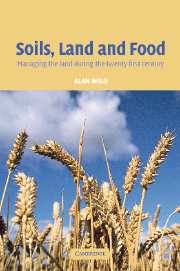Book contents
- Frontmatter
- Contents
- Preface
- Acknowledgements
- 1 Managing land for food production in the twenty-first century: an outline
- 2 Natural resources for sustainable land management
- 3 The development of agriculture and systems of land management
- 4 Maintaining and improving soil fertility
- 5 Land degradation and its control
- 6 Raising yields: use of fertilizers
- 7 Raising yields: water for rainfed crops and irrigation
- 8 Managing change of land use: seven examples
- 9 Increasing and sustaining agricultural production
- 10 Increasing agricultural production: the examples of Africa, India and China
- 11 Prospects and uncertainties
- References
- Index
3 - The development of agriculture and systems of land management
Published online by Cambridge University Press: 05 June 2012
- Frontmatter
- Contents
- Preface
- Acknowledgements
- 1 Managing land for food production in the twenty-first century: an outline
- 2 Natural resources for sustainable land management
- 3 The development of agriculture and systems of land management
- 4 Maintaining and improving soil fertility
- 5 Land degradation and its control
- 6 Raising yields: use of fertilizers
- 7 Raising yields: water for rainfed crops and irrigation
- 8 Managing change of land use: seven examples
- 9 Increasing and sustaining agricultural production
- 10 Increasing agricultural production: the examples of Africa, India and China
- 11 Prospects and uncertainties
- References
- Index
Summary
INTRODUCTION
Starting about 10000 years ago in western Asia a slow change began in the way people procured food. For many thousands of years they had relied wholly on hunting animals, fishing, and gathering plants, tubers and seeds. Now they began, in addition, to sow or plant a few species of plants and keep domestic and scavenging animals. Permanent settlements were established at watering-places and food was stored for times of shortage. At some centres urban civilizations developed. Hunting and gathering continued to provide food but to a progressively decreasing extent. This change from hunting and gathering to settled farming, which occurred at different times in different places, is known as the Neolithic or Agricultural Revolution because of the effects it had on human society.
From its very beginning farming has changed and evolved. From the work of archaeologists and historians we now know, though as yet imperfectly, something of the techniques that have been used during the last 10 000 years. We also know that some of the civilizations survived for very long periods while others failed or struggled to survive. Reasons for failure include climate change, as occurred in Iceland and Greenland around 800 years ago, and methods of land management that did not sustain food production, as probably occurred in Central America at the time of the Mayan civilization. Lessons for the future can be learned from the successes and failures of the past.
- Type
- Chapter
- Information
- Soils, Land and FoodManaging the Land during the Twenty-First Century, pp. 23 - 50Publisher: Cambridge University PressPrint publication year: 2003



